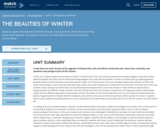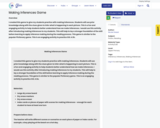
In this unit, students explore the beauties of winter. In the first part of the unit students pretend to be meteorologists as they learn about different weather forecasts and the words that meteorologists use to describe the weather in winter. Students start by exploring generic weather words and then transition into winter-specific words. In the second part of the unit, students explore how animals survive in the winter and the ways in which animals meet their basic needs, even when the ground is covered with ice and snow. In the last part of the unit, students read a variety of Jan Brett texts and use what they have learned about snow and animals to make inferences about what is happening with the different winter animals in the text. By the end of the unit, students should have a strong grasp of what makes winter unique and the different ways plants and animals survive in the winter. Due to the timing of this unit, it is our hope that students will have plenty of opportunities to interact with the vocabulary and content in the natural world around them. When outside for recess or anytime that it snows, students should be pushed to use the vocabulary and content they are learning in the unit so that the content can fully come to life.
In reading, this unit is predominately a collection of informational texts and builds on skills and strategies from earlier units. At this point it is assumed that students are inquisitive consumers of text and are able to ask and answer questions about a text in order to deepen understanding of the content. In this unit, students will continue to be challenged to identify the main topic of a text, retell the key details that connect to the main topic, describe the connection between ideas in a text, and use the illustrations and words to describe and retell what is happening in a text with varying levels of teacher support. Students will also begin to use strategies to ask and answer questions about unknown words in a text, specifically those connected to weather and snow. As part of daily text introductions, students will also continue to explore the purpose behind text features, specifically the front cover, back cover, and title page of a book, and how each feature supports understanding of the text. Many of the skills and strategies in this unit are spiraled from earlier units or will be spiraled through upcoming units; therefore, it is up to the teacher to decide what level of support students need with the particular strategy and scaffold accordingly.
In writing, students will continue to write daily in response to the text. At this point in the year, students should be using a combination of drawing and words to correctly answer the question. Pick focus teaching points based on data from previous units and individual student needs.
- Subject:
- Communication and Multimodal Literacy
- English
- Fiction
- Reading
- Writing
- Material Type:
- Assessment
- Homework/Assignment
- Lesson Plan
- Provider:
- Match Fishtank
- Provider Set:
- Fishtank ELA
- Date Added:
- 01/01/2017

